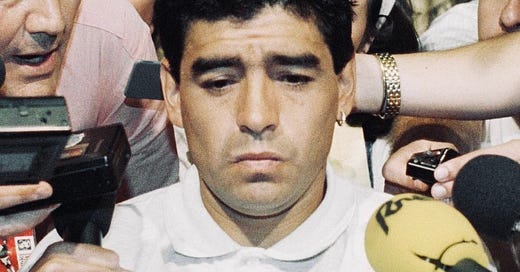For a brief moment, that summer in the US, Diego Armando Maradona seemed eternal. With one last dance in the No. 10 shirt, he was surely destined to be Argentina’s hero for once more... But then came the test.
A FIFA press conference broke the news to the world. Maradona had failed a drug test following his side’s 2–1 win over Nigeria. Traces of ephedrine, a banned stimulant, had been detected in his system. He was out of the tournament. Out of football.
In truth, Maradona had been walking a fine line before the World Cup began. Now back playing club football in his homeland at the age of 33, his body showed signs of decline, even as his mind raged against it. Diego was no longer ‘El Pibe de Oro’, the boy wonder of 1986. The Maradona of USA ’94 was something else.
But for just a few days that June, he lit up a World Cup yet again. His first goal of the tournament, against Greece, was a reminder of his talent. The famously crazed celebration, though, may have told a different story. Sprinting to the touchline, face contorted, he screamed maniacally into the camera.
Behind the scenes, the warning signs had been there. Maradona’s reinstatement to the national team, after a 15-month ban for cocaine use in ‘91, was arguably desperate on manager Alfio Basile’s part. However, the Albiceleste’s old talisman had played like a man possessed in qualification, securing a ticket to the US.
Yet, just two matches into the tournament, it was all over. The ephedrine found was blamed on a mysterious “energy drink” supplied by a personal trainer. FIFA wasn’t interested in excuses and sent Maradona packing. Argentina, left rudderless, lost their next two matches and crashed out in the round of 16.
After the World Cup, Maradona’s career unravelled with his days in the iconic blue and white shirt over indefinitely. The sad image of him trudging through the airport became a grim bookend to his international career.
For the national team, a new generation of talented players like Gabriel Batistuta, Diego Simeone and Mauricio Pochettino led the rebuild, but Diego’s absence left a lingering void. One which Argentina would, arguably, not fill until the arrival of a certain Lionel Messi over a decade later.
Maradona’s club career spiralled too. A brief stint with Newell’s Old Boys had preceded the World Cup. After his ban, he returned to Boca Juniors, where it had all begun. At La Bombonera, he found some happiness but little of his old brilliance. By 1997, the journey was over and he announced his retirement on his 37th birthday.
Diego Maradona’s post-career life was equally as chaotic, but he remains adored–even worshipped–by his country.




